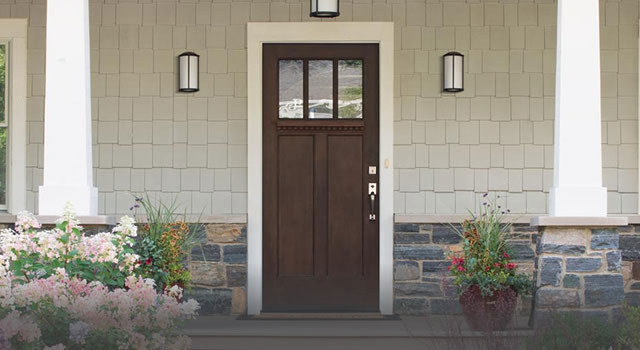

How do you know that it is time to replace your front door? These days it seems that people don’t use their front door as much as they used to. With garage entries and side doors, most of us don’t even think about our front doors. Most of us understand that we need to replace our old single-paned, non-energy efficient windows, we don’t consider our doors.
Here are some great reasons to consider updating your door systems:

1. Does your daily workout consist of simply trying to open and close the front door?
If your door is difficult to open and close, it may be time to replace it. When you feel your door sticking in the winter and easy to open and close in the summer, that’s a sure sign of energy rushing out your door. If the hinges are sinking, that’s another issue. But if it’s sticking in the door jam, your door likely has exposed areas either down the sides, the top or the bottom where you might be able to see light. Seeing light from the inside or the outside of a closed door is a problem.
2. Is your door weathered, warped, or cracked?
Doors can take a beating over their lifetime. They’re slammed, kicked and exposed to huge temperature changes in our Canadian climate. If you have an older solid wood door, it has probably seen better days. Many of these doors have expanded and contracted over so many summers and winters that they have cracked, are warped and are extremely weathered. When you inspect your older wooden door, look for light coming into the room from the “solid” wood door. Many of these doors have stress fractures in the grains of the door. These stress fractures expose your home to the outside elements.
3. Have you noticed water damage or insect damage?
If you have water damage, you know that the wood should be replaced. If the wood is soft and/or breaking apart it may not be secure enough to support the door structure. You should replace your entry door if this is a problem. The same applies to insect damage. If your exterminator told you that the wood’s structure was compromised, your R-Value (energy efficiency through solid objects) could be significantly diminished. Not only is your home easier to break into, but you’re also inviting more pathways for water or insects to damage your entryway, as well as wasting your interior heat and cooling through leakage. Loss of R-Value can be significant when it comes to a door because it is your thermal barrier.
4. Does your door have more dings and rust than a junk yard car?
Dings and rust on a door shows that the structural integrity of the door may have been compromised. Most off-the-shelf residential doors are laminated 24-26 gauge steel on top of a wood core. Has your door become soft and fragile? Moisture may have impacted the interior core of the door, and should rust come into the equation, it’s time to replace that door!
How do you know that it is time to replace your front door? These days it seems that people don’t use their front door as much as they used to. With garage entries and side doors, most of us don’t even think about our front doors. Most of us understand that we need to replace our old single-paned, non-energy efficient windows, we don’t consider our doors.
Here are some great reasons to consider updating your door systems:

1. Does your daily workout consist of simply trying to open and close the front door?
If your door is difficult to open and close, it may be time to replace it. When you feel your door sticking in the winter and easy to open and close in the summer, that’s a sure sign of energy rushing out your door. If the hinges are sinking, that’s another issue. But if it’s sticking in the door jam, your door likely has exposed areas either down the sides, the top or the bottom where you might be able to see light. Seeing light from the inside or the outside of a closed door is a problem.
2. Is your door weathered, warped, or cracked?
Doors can take a beating over their lifetime. They’re slammed, kicked and exposed to huge temperature changes in our Canadian climate. If you have an older solid wood door, it has probably seen better days. Many of these doors have expanded and contracted over so many summers and winters that they have cracked, are warped and are extremely weathered. When you inspect your older wooden door, look for light coming into the room from the “solid” wood door. Many of these doors have stress fractures in the grains of the door. These stress fractures expose your home to the outside elements.
3. Have you noticed water damage or insect damage?
If you have water damage, you know that the wood should be replaced. If the wood is soft and/or breaking apart it may not be secure enough to support the door structure. You should replace your entry door if this is a problem. The same applies to insect damage. If your exterminator told you that the wood’s structure was compromised, your R-Value (energy efficiency through solid objects) could be significantly diminished. Not only is your home easier to break into, but you’re also inviting more pathways for water or insects to damage your entryway, as well as wasting your interior heat and cooling through leakage. Loss of R-Value can be significant when it comes to a door because it is your thermal barrier.
4. Does your door have more dings and rust than a junk yard car?
Dings and rust on a door shows that the structural integrity of the door may have been compromised. Most off-the-shelf residential doors are laminated 24-26 gauge steel on top of a wood core. Has your door become soft and fragile? Moisture may have impacted the interior core of the door, and should rust come into the equation, it’s time to replace that door!

Customer Service
1-855-561-1114

Copyright 2023 Turkstra Lumber Company Ltd. | Privacy Policy | All Rights Reserved












